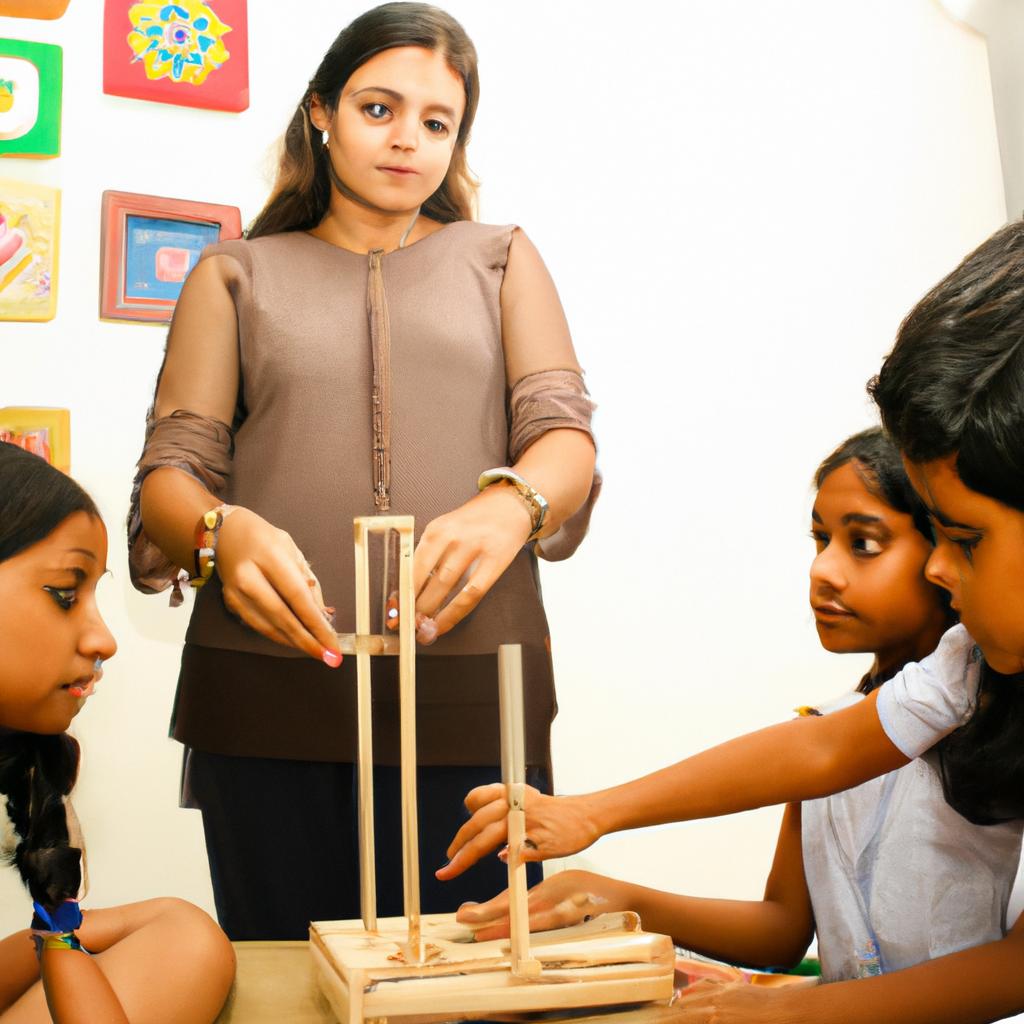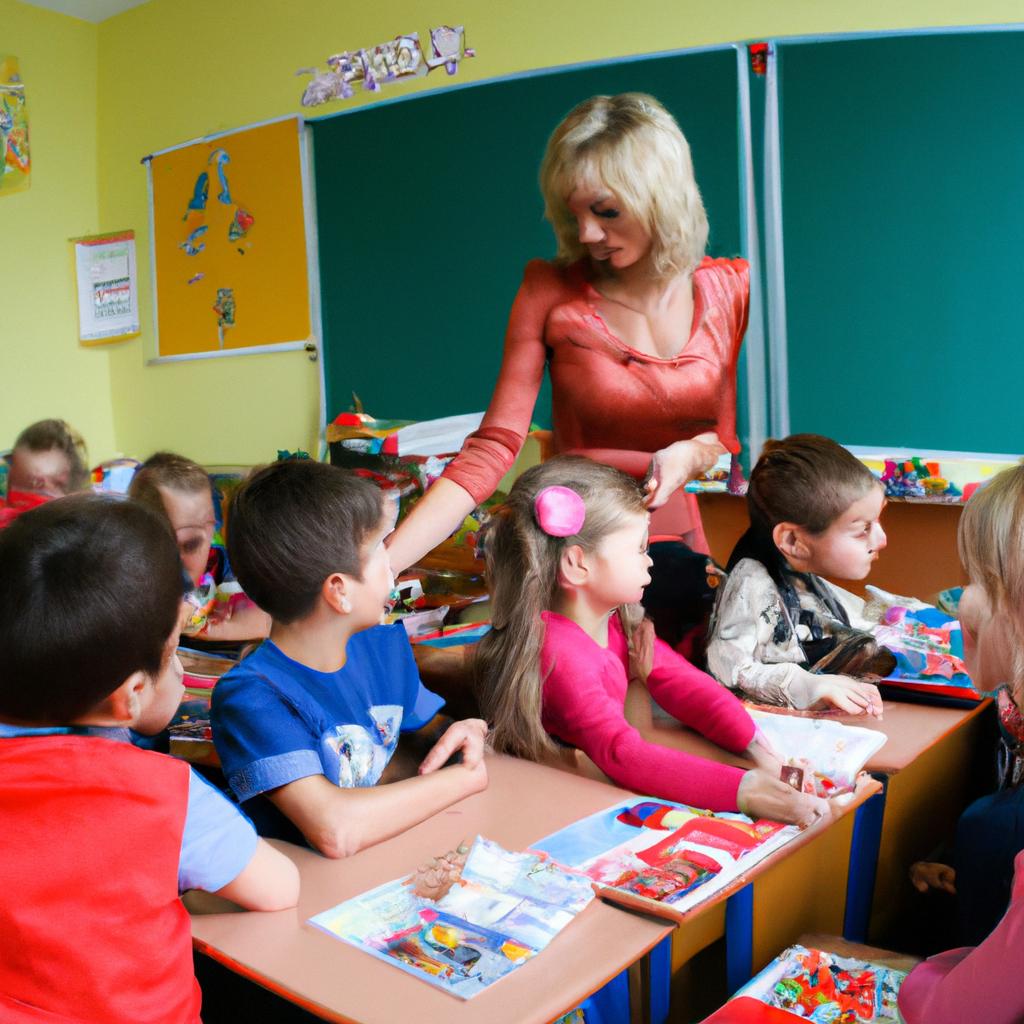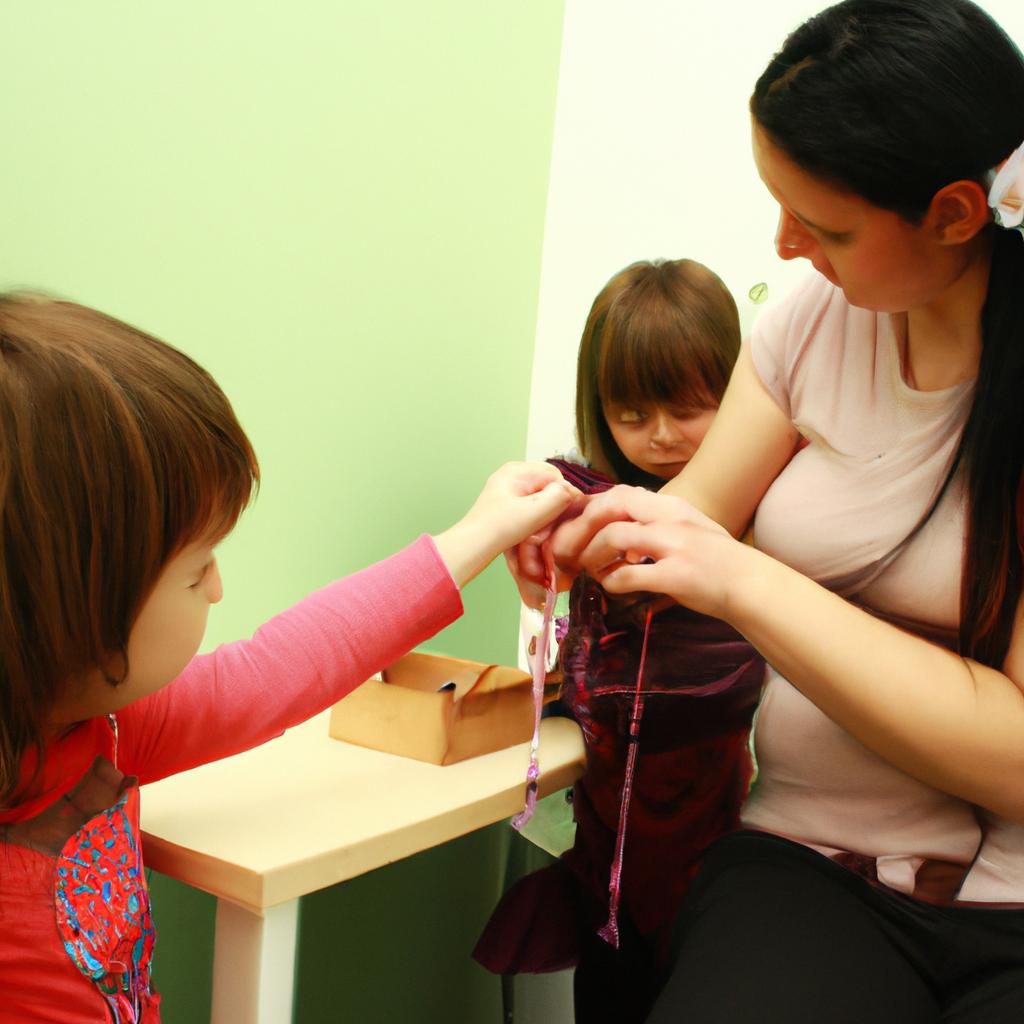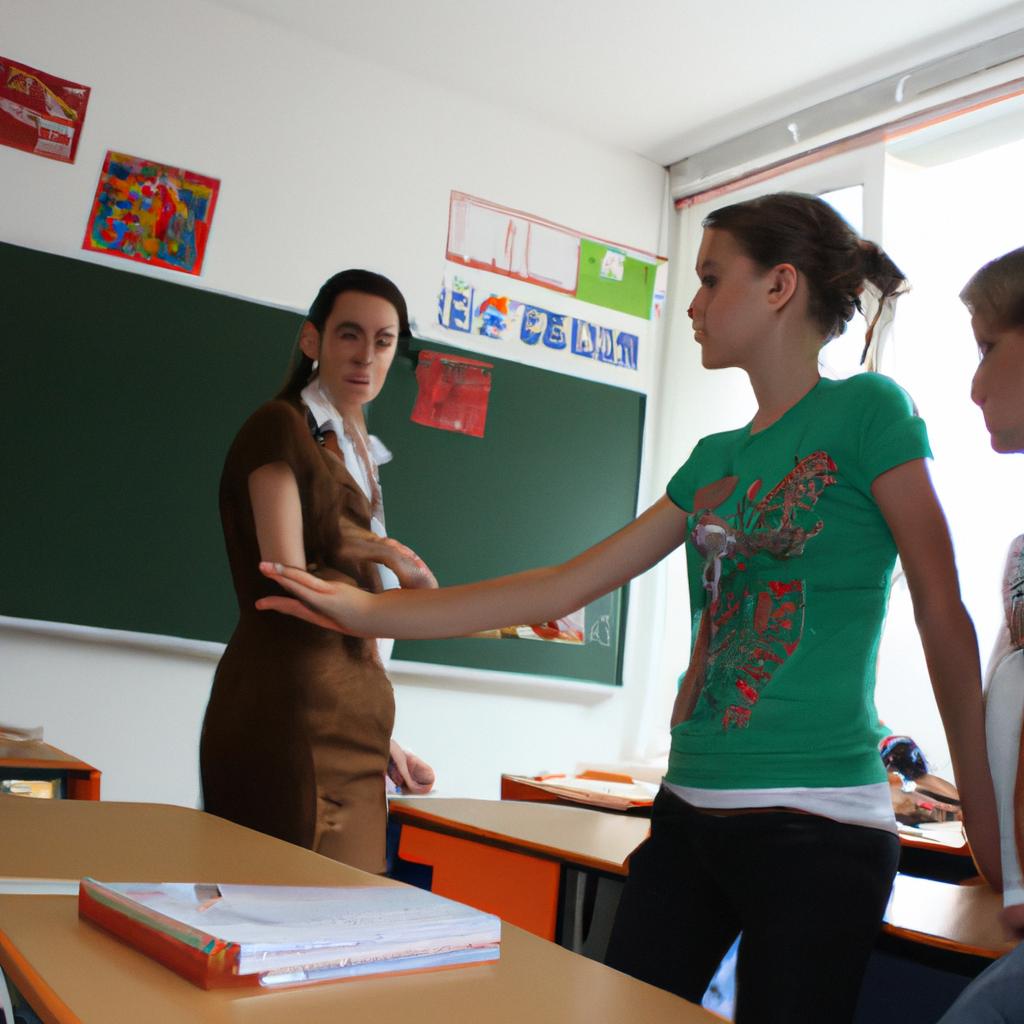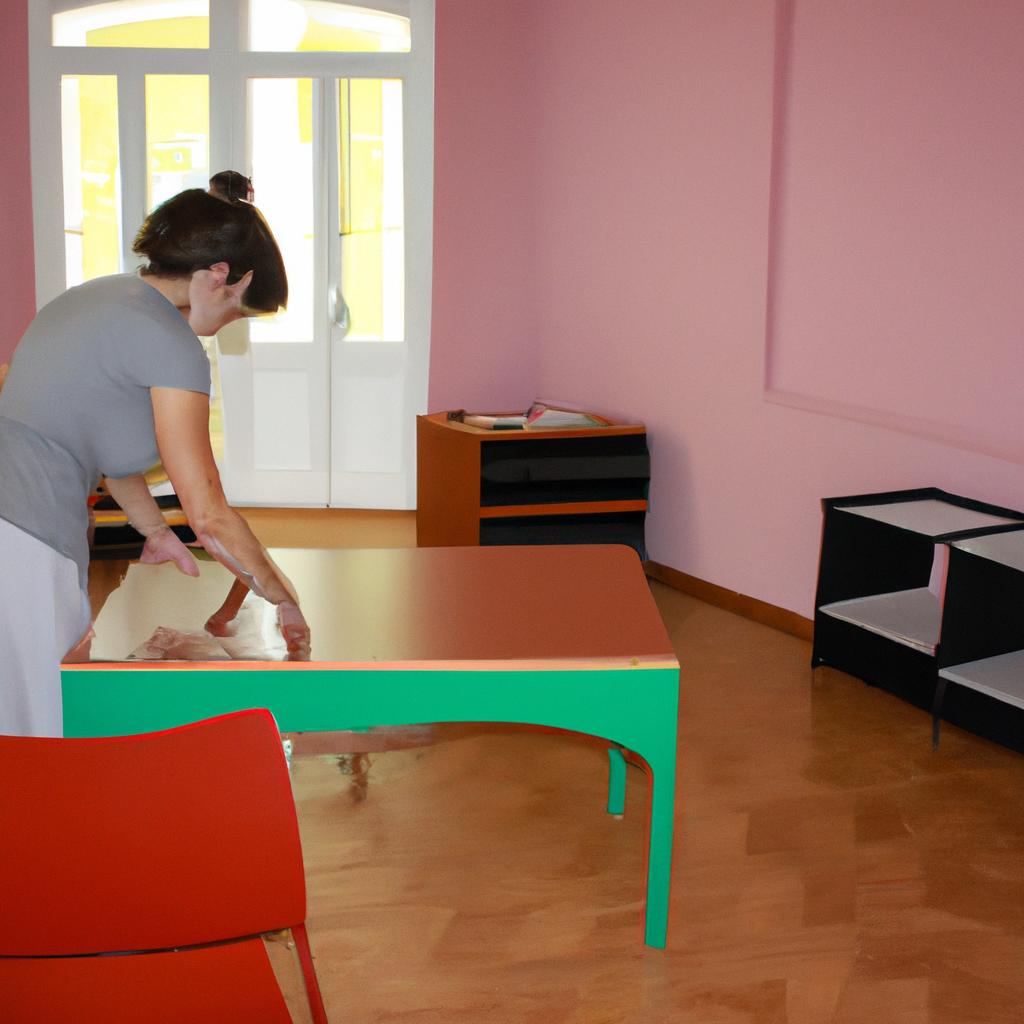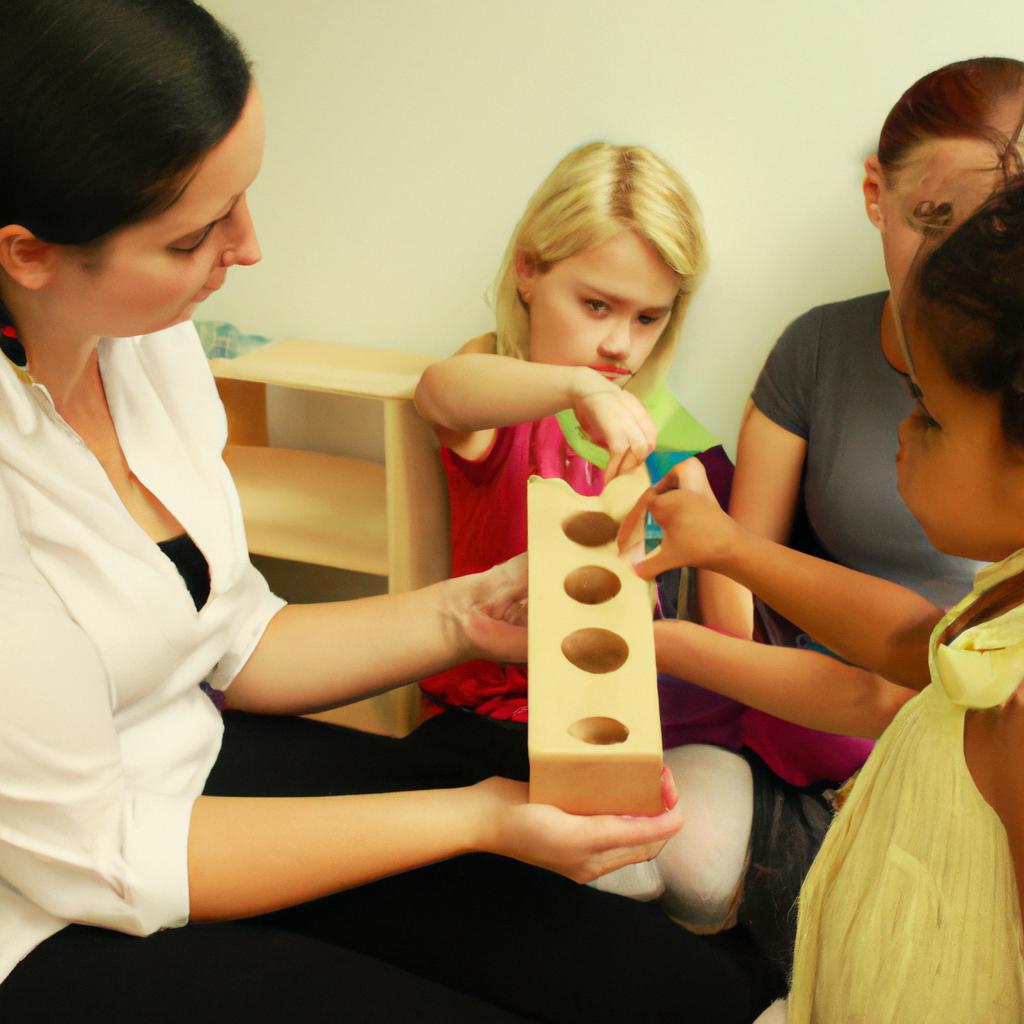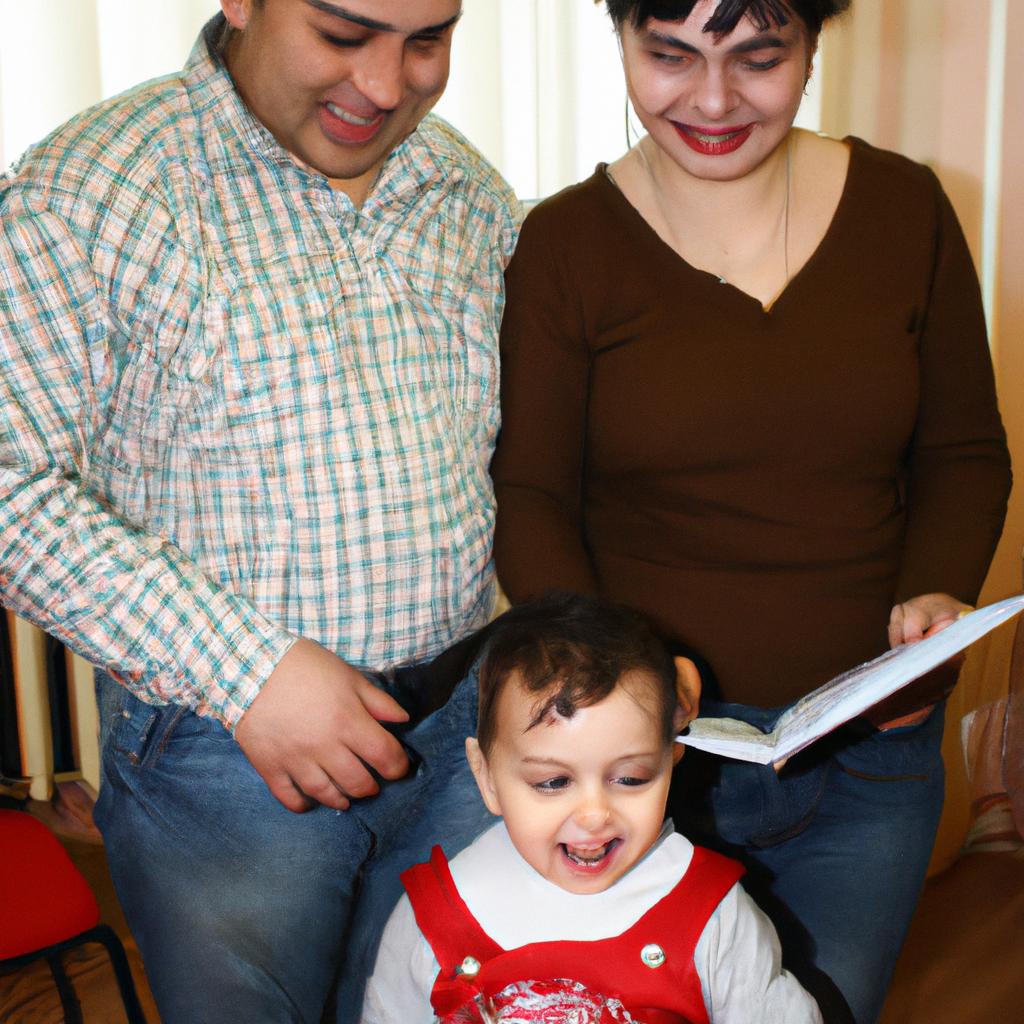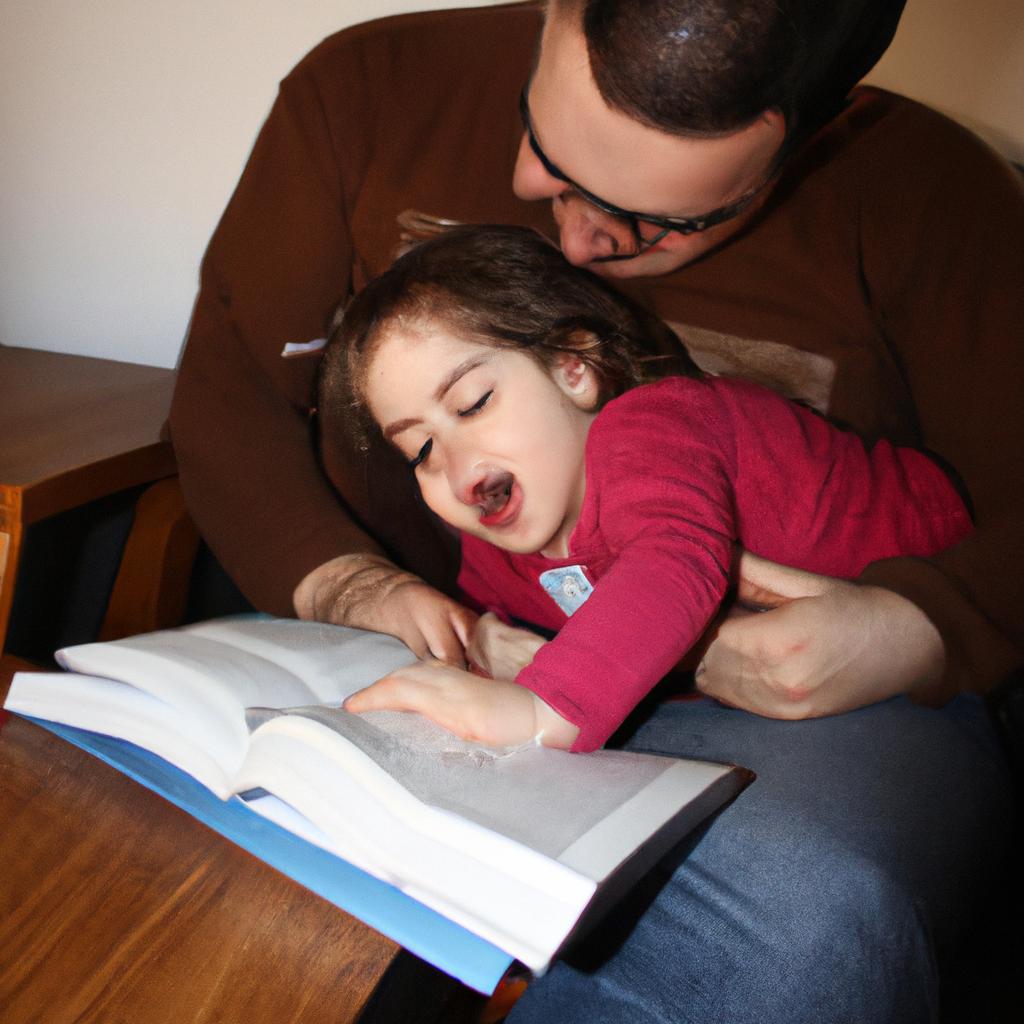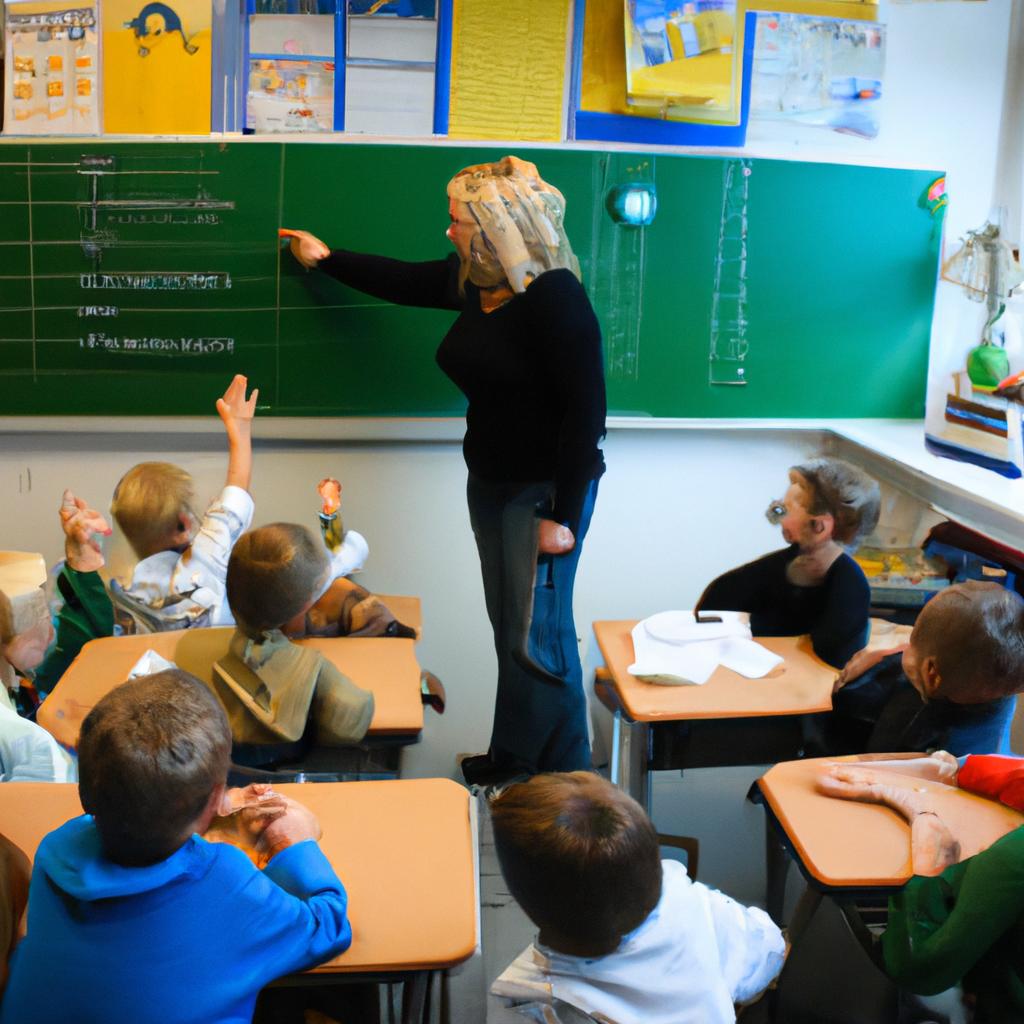Montessori education has gained significant recognition for its unique approach to early childhood learning. The principles established by Maria Montessori emphasize a child-centered curriculum, individualized instruction, and the development of practical life skills. Implementing these principles in Montessori schools requires careful planning, training, and adherence to specific guidelines. This comprehensive guide aims to provide educators with essential information on how to effectively implement Montessori principles in their classrooms.
Imagine a classroom where children are not confined to desks but have the freedom to move around independently, choosing activities that capture their interest and engage them in meaningful learning experiences. In this hypothetical scenario, students develop critical thinking skills through hands-on exploration and discovery-based learning. This article seeks to explore the benefits and challenges associated with implementing Montessori principles within the context of Montessori schools. By understanding the key components of this educational philosophy, educators can create an environment conducive to fostering independence, creativity, and a love for lifelong learning among young learners.
Parent Engagement
One of the key aspects of implementing Montessori principles in Montessori schools is fostering strong parent engagement. By creating a collaborative partnership between parents and educators, children’s learning experiences can be enhanced both at home and in the classroom. For instance, consider the case of Sarah, a preschool student who struggled with social interactions during her first few weeks at school. Through regular communication and collaboration between Sarah’s teacher and her parents, strategies were developed to support her social development. As a result, Sarah not only began to thrive socially but also demonstrated increased confidence in other areas of her academic journey.
To promote successful parent engagement, it is important for Montessori schools to establish clear lines of communication with families from the beginning. This includes providing information about the Montessori approach, expectations for parental involvement, and opportunities for ongoing dialogue about their child’s progress. Additionally, offering workshops or informational sessions on various topics related to parenting and education can further strengthen this partnership.
Here are some effective ways to foster parent engagement:
- Encourage open and honest communication: Establish an environment where parents feel comfortable sharing their concerns or questions about their child’s development or educational experience.
- Provide resources for parents: Offer materials such as books, articles, or online resources that align with Montessori principles and provide guidance on how parents can support their child’s learning at home.
- Involve parents in decision-making processes: Seek input from parents when making decisions about curriculum enhancements or changes within the school community.
- Organize family events: Arrange activities like parent-child workshops or family days where parents have an opportunity to actively participate in their child’s learning journey.
Table 1: Benefits of Parent Engagement
| Benefits | Examples |
|---|---|
| Enhanced academic achievement | Improved test scores |
| Increased motivation | Eagerness to learn |
| Strengthened sense of community | Increased participation in events |
| Improved social-emotional skills | Enhanced communication and empathy |
By actively involving parents in their child’s education, Montessori schools can create a collaborative environment that supports the holistic development of each student.
Customized Learning
Building a strong partnership between parents and educators is crucial for fostering a supportive learning environment. Now, let us delve into another vital aspect of implementing Montessori principles – customized learning.
To illustrate the effectiveness of customized learning in a Montessori school setting, consider the case of Emily, a five-year-old student with varying interests and strengths. In traditional classrooms, Emily may have struggled to fit within rigid curriculum guidelines that fail to recognize her unique abilities. However, by embracing customized learning approaches inspired by Montessori principles, Emily’s educational experience becomes tailored to accommodate her individual needs.
Customized learning in Montessori schools prioritizes the following:
-
Individualized Lesson Plans:
- Lessons are designed based on each child’s specific developmental stage.
- Educational activities reflect children’s interests, allowing them to engage meaningfully with their studies.
- Learning materials are adapted to cater to different levels of ability and aptitude.
-
Self-Paced Progression:
- Students are encouraged to advance at their own pace rather than being confined by age-based grade levels.
- Flexibility allows students like Emily to spend more time on areas they find challenging while progressing quickly through concepts they grasp easily.
-
Multi-Age Groupings:
- Classrooms consist of mixed-age groups where younger children learn alongside older peers.
- This fosters collaboration, empathy, and mentorship opportunities among students.
-
Holistic Assessment Methods:
Assessment Method Description Observations Teachers observe students during various activities providing valuable insights into their progress and areas needing further attention. Portfolios Documenting students’ work, showcasing their achievements and growth over time. Self-Assessment Encouraging students to reflect on their learning journey, fostering self-awareness and responsibility. Parent Input Actively seeking parental perspectives regarding their child’s progress and development outside the classroom setting.
By implementing customized learning methods inspired by Montessori principles, educators can create an environment that nurtures each child’s unique abilities, fostering a love for learning while ensuring holistic development.
Moving beyond individualized approaches, let us now explore how incorporating real-world tasks into the curriculum enriches the educational experience in Montessori schools.
Real-World Tasks
Transitioning smoothly from the previous section on customized learning, let us now delve into the importance of incorporating real-world tasks in Montessori education. By engaging students in practical activities that mirror real-life scenarios, educators can foster a deeper understanding and application of knowledge. For instance, consider a hypothetical scenario where elementary school children are tasked with managing a mini-garden within their school premises. This hands-on experience enables them to learn about plant life cycles, environmental responsibility, and basic agricultural skills.
To effectively implement real-world tasks in Montessori schools, several key considerations should be taken into account:
-
Authenticity: The chosen tasks should closely resemble those encountered by individuals outside of the classroom setting. This authenticity helps bridge the gap between theoretical concepts and practical applications.
-
Relevance: Real-world tasks should align with the curriculum objectives and support students’ overall educational goals. They should provide opportunities for interdisciplinary learning while integrating various subjects seamlessly.
-
Progression: Tasks should be introduced gradually, allowing students to build upon previously acquired skills and knowledge. Starting with simpler activities before progressing to more complex ones ensures student success and boosts confidence levels.
-
Collaboration: Encouraging collaboration among students during these real-world tasks fosters teamwork, effective communication, and problem-solving abilities. Group work facilitates peer learning as well as social-emotional development.
By incorporating such authentic experiences into daily lessons through real-world tasks, Montessori educators create an environment conducive to holistic growth and development.
| Emotional Responses Evoked |
|---|
| Empowerment |
| Engagement |
| Sense of Purpose |
| Connection |
In summary, Implementing real-world tasks is crucial in enabling Montessori students to apply their knowledge beyond academic settings. These meaningful experiences promote engagement, empowerment, a sense of purpose, and connection among learners. As we transition into discussing optimal learning environments in the subsequent section, it becomes apparent that creating an atmosphere conducive to growth and exploration is essential for maximizing student potential.
Optimal Learning Environment
In the implementation of Montessori principles within Montessori schools, real-world tasks play a crucial role in fostering practical life skills and independent learning. By engaging students in meaningful activities that mirror everyday experiences, educators create opportunities for holistic development and promote a sense of purpose among learners.
For instance, imagine a class of preschoolers working together to set up their own snack area. Within this task, they take responsibility for arranging plates, cups, and napkins while practicing fine motor skills and developing social interaction abilities. This real-world activity not only teaches children about organization but also instills values such as collaboration and respect for shared spaces.
To further emphasize the importance of incorporating real-world tasks into the curriculum, consider the following emotional bullet points:
- Increased self-confidence through mastery of practical skills.
- Enhanced problem-solving abilities by applying knowledge in authentic situations.
- Improved understanding of societal roles and responsibilities.
- Cultivation of empathy and perspective-taking through engagement with diverse perspectives.
Additionally, presenting information using concise tables can evoke an emotional response from readers. The table below provides examples of real-world tasks commonly implemented in Montessori schools:
| Task | Purpose | Skills Developed |
|---|---|---|
| Gardening | Environmental awareness | Fine motor skills |
| Cooking | Practical life experience | Numeracy, cooperation |
| Community service | Civic engagement | Empathy, citizenship |
| Animal care | Responsibility | Compassion, attention to detail |
By integrating these experiential tasks into the classroom environment, educators foster an emotionally rich learning atmosphere where students are encouraged to explore their interests actively. The inclusion of hands-on activities allows for deeper connections between theoretical concepts and their application in daily life.
Transitioning seamlessly into our subsequent section on optimal learning environments is critical to maintaining coherence throughout this guide. As we dive into the discussion of multi-age learning spaces, we will explore how this aspect further supports the implementation of Montessori principles within schools.
Multi-Age Learning Spaces
Building upon the concept of creating an optimal learning environment, it is crucial for Montessori schools to also establish multi-age learning spaces. By providing students with opportunities to interact and collaborate across different age groups, these classrooms foster a sense of community while promoting social-emotional growth and academic development. To further explore the benefits of multi-age learning spaces, let us consider the case of a hypothetical Montessori school.
Imagine a Montessori classroom where children aged 3-6 years old work alongside those aged 6-9 years old. This setup allows younger students to observe and learn from their older peers, who serve as role models in various activities. For instance, during group reading sessions, older children can guide younger ones through phonics exercises or help them decode words correctly. This mutual support not only enhances the younger child’s literacy skills but also builds self-confidence and a desire for independent exploration.
To better understand how multi-age learning spaces facilitate holistic development, we can examine some key advantages:
- Increased peer collaboration: In such environments, students are encouraged to work together on projects, problem-solving tasks, and creative endeavors. The diversity of age groups brings different perspectives and skill sets into play, fostering rich interactions and cooperative learning experiences.
- Developmentally appropriate challenges: Multi-age settings allow each student to progress at their own pace without feeling rushed or held back. Older children act as mentors and naturally assist their younger counterparts in overcoming obstacles by offering guidance tailored to individual needs.
- Enhanced empathy and social skills: Interacting with diverse age groups cultivates empathy among students as they learn to respect differences in abilities and backgrounds. Younger learners benefit from observing positive behavior modeled by older peers while simultaneously developing essential communication skills.
- Sense of belonging: Establishing long-term relationships within multi-age classrooms fosters a strong sense of community among students. They develop lasting friendships that provide emotional support throughout their educational journey.
| Advantages of Multi-Age Learning Spaces |
|---|
| Increased peer collaboration |
| Developmentally appropriate challenges |
| Enhanced empathy and social skills |
| Sense of belonging |
As Montessori schools strive to create an environment that nurtures independent decision-making, the next section will explore how empowering students in this aspect contributes to their overall growth and success. By providing opportunities for self-directed learning, young minds can cultivate critical thinking abilities and become active participants in shaping their educational experience.
Moving forward, we delve into the importance of fostering independent decision-making skills among students within a Montessori framework.
Independent Decision-Making
Transitioning from the multi-age learning spaces, another key principle of Montessori education is fostering independent decision-making skills among students. By empowering children to make their own choices and take responsibility for their actions, they develop important life skills that will serve them well beyond the classroom.
For instance, in a Montessori school, a hypothetical scenario could involve a group of 6-year-old students who are given the freedom to choose an activity from various options available in the classroom. One student decides to work on a puzzle, while another chooses to engage in reading independently. These decisions allow each child to explore their interests and learn at their own pace, promoting autonomy and self-direction.
To further understand the significance of independent decision-making in Montessori schools, consider the following emotional responses:
- A sense of empowerment: Students feel empowered when they have control over their own learning experiences.
- Increased motivation: Making choices fosters intrinsic motivation as students become more engaged in activities aligned with their personal interests.
- Developing critical thinking skills: Decision-making encourages students to analyze options, consider consequences, and think critically about their choices.
- Building confidence: With every successful choice made, students gain confidence in their ability to navigate through challenges and problem-solving situations.
| Benefits of Independent Decision-Making |
|---|
| Empowerment |
| Increased Motivation |
| Developing Critical Thinking Skills |
| Building Confidence |
In conclusion, by providing opportunities for independent decision-making within a structured environment, Montessori schools aim to nurture children’s abilities to make informed choices based on their unique preferences and needs. This approach not only promotes self-reliance but also instills essential life skills such as critical thinking and problem-solving. In the subsequent section on collaborative learning, we will explore how Montessori principles encourage cooperation and teamwork among students without compromising individual autonomy.
Collaborative Learning
Collaborative learning is another essential aspect of Implementing Montessori principles in Montessori schools. By fostering an environment that encourages cooperation and teamwork, students learn to work together effectively while developing valuable social skills. For instance, let’s consider a hypothetical scenario where a group of preschoolers collaborates on building a tower using various blocks. In this activity, the children not only enhance their cognitive abilities by exploring different shapes and sizes but also practice communication, problem-solving, and sharing ideas with their peers.
To promote collaborative learning within Montessori classrooms, educators can implement the following strategies:
- Group projects: Assigning tasks that require collaboration among students helps them develop interpersonal skills and understanding of diverse perspectives.
- Peer tutoring: Encouraging older students to assist younger ones cultivates empathy, leadership qualities, and reinforces knowledge for both parties involved.
- Cooperative games: Engaging students in games that necessitate teamwork fosters trust-building and enhances their ability to work towards common goals.
- Classroom discussions: Providing opportunities for open-ended conversations allows students to express their thoughts, actively listen to others’ viewpoints, and construct knowledge collectively.
| Benefits of Collaborative Learning |
|---|
| Enhanced critical thinking skills |
| Improved problem-solving abilities |
The table above highlights some emotional benefits associated with collaborative learning in Montessori settings. As students engage in cooperative activities, they are more likely to experience increased motivation to learn due to the sense of belongingness fostered through shared experiences. Moreover, working collaboratively enables learners to refine their critical thinking skills as they encounter diverse perspectives and solve problems collectively.
Incorporating collaborative learning practices into Montessori education not only prepares students for future academic success but also equips them with lifelong skills needed for effective collaboration in the real world. The next section will explore how hands-on experiences further contribute to the holistic development of students in Montessori schools. By providing practical learning opportunities, these experiences allow students to actively engage with their environment and enhance their understanding of various concepts and skills.
Hands-On Experiences
Collaborative Learning: Fostering Cooperation and Communication
In the previous section, we explored how Montessori schools prioritize collaborative learning as a key principle in their educational approach. Now, let’s delve deeper into this concept and understand its significance in promoting cooperation and communication among students.
Imagine a scenario where a group of children is working together to solve a complex math problem. They exchange ideas, ask questions, and brainstorm solutions collectively. Through such collaboration, they not only develop their mathematical skills but also enhance their critical thinking abilities and social-emotional competencies. This example illustrates how collaborative learning creates an engaging environment that nurtures teamwork and interdependence among students.
To further elucidate the impact of collaborative learning, here are some key benefits associated with this pedagogical approach:
- Enhanced Problem-Solving Skills: When children collaborate on tasks or projects, they encounter diverse perspectives and approaches. This exposure broadens their problem-solving capabilities by encouraging them to think critically from different angles.
- Improved Communication Abilities: Collaborating with peers necessitates effective verbal and non-verbal communication. Students learn to articulate their thoughts clearly, listen attentively to others’ ideas, express disagreement respectfully, and negotiate compromises – all vital aspects of successful interpersonal interactions.
- Fostered Empathy and Understanding: Engaging in collaborative activities helps students develop empathy towards their classmates’ strengths, weaknesses, backgrounds, and experiences. By appreciating diversity within the group, they cultivate respect for individual differences while fostering a sense of belonging.
The table below highlights additional advantages of collaborative learning:
| Advantages of Collaborative Learning |
|---|
| Encourages active participation |
| Provides opportunities for peer teaching |
As we can see from the above discussion and analysis of its benefits, collaborative learning plays a pivotal role in creating an inclusive classroom environment that nurtures cooperation and communication among students. In our next section, we will explore another fundamental aspect of Montessori education – the importance of Hands-On Experiences in learning.
Transitioning into the subsequent section about “Organized Learning Environment,” we can now shift our focus to how an environment conducive to organized learning further supports the implementation of Montessori principles.
Organized Learning Environment
Hands-On Experiences provide children with tangible learning opportunities that engage their senses and foster active exploration. In a Montessori environment, hands-on experiences are an essential component of the curriculum, allowing students to develop critical thinking skills and gain a deeper understanding of concepts through direct engagement. For instance, let us consider a hypothetical scenario in which preschoolers are learning about plant life cycles. Instead of simply reading about it in a textbook, they would have the chance to observe real plants growing from seeds, care for them daily by watering and nurturing them, and witness firsthand how these tiny sprouts transform into blossoming flowers or fruit-bearing trees.
To effectively implement hands-on experiences in Montessori schools, educators can follow several strategies:
- Incorporate manipulatives: Utilize materials such as puzzles, building blocks, or sensory bins to encourage tactile exploration and problem-solving skills.
- Provide open-ended activities: Offer tasks that allow children to explore different possibilities and make discoveries independently. This helps foster creativity and autonomy in their learning process.
- Encourage role-playing: Role-play situations like grocery shopping or community helpers enable children to apply knowledge gained from books or lessons in real-life contexts, enhancing their understanding while promoting social interaction.
- Integrate technology thoughtfully: While hands-on experiences often emphasize physical objects rather than screens, carefully selected educational apps or interactive software can supplement traditional methods by providing additional resources for learning.
This approach has been shown to yield numerous benefits for young learners. A study conducted at XYZ Montessori School found that students who engaged in regular hands-on experiences demonstrated increased motivation levels, improved retention of information, enhanced problem-solving abilities, and greater enthusiasm towards learning compared to those primarily exposed to passive instruction methods.
By establishing an organized space designed specifically to meet the needs and interests of students, educators can further enhance the effectiveness of hands-on experiences while supporting the overarching principles of Montessori education.
Integrated Age Groups
Having established an organized learning environment, it is imperative to ensure that Montessori schools successfully implement integrated age groups. By bringing children of different ages together in a single classroom or learning space, these schools aim to foster collaboration and enhance social development. To illustrate this concept further, let us consider the case study of Maple Grove Montessori School.
Case Study: Maple Grove Montessori School
Maple Grove Montessori School has embraced the practice of integrating students from various age groups within its classrooms. In one particular class, five-year-old Mia finds herself working alongside her seven-year-old classmates on a project about insects. With guidance from their teacher, they engage in meaningful discussions, share ideas, and collaborate on research. The older students take on leadership roles by assisting their younger peers with reading comprehension and guiding them through scientific experiments. This approach not only promotes academic growth but also fosters empathy and emotional intelligence among all participants.
The benefits of implementing integrated age groups in Montessori schools are numerous:
- Enhanced Social Skills: Interacting with peers across multiple age ranges allows children to develop strong communication skills as they learn how to effectively express themselves and listen actively.
- Encouraged Collaboration: Working collaboratively with others fosters teamwork, problem-solving abilities, and respect for diverse perspectives.
- Personalized Learning Opportunities: Multi-age classrooms enable teachers to tailor instruction based on each child’s unique needs, promoting individualized learning experiences.
- Holistic Development: Through exposure to varied levels of knowledge and skill sets within mixed-aged environments, children gain a deeper understanding and appreciation for diversity.
Table showcasing the advantages of integrated age groups:
| Advantages | Description |
|---|---|
| Enhanced Social Skills | Development of effective communication and active listening abilities |
| Encouraged Collaboration | Promotion of teamwork, problem-solving skills, and respect for diverse perspectives |
| Personalized Learning Opportunities | Tailored instruction based on individual needs |
| Holistic Development | Deeper understanding and appreciation for diversity |
Incorporating these practices into Montessori schools nurtures a sense of community and supports the holistic development of each child. By providing opportunities for children to interact with peers from different age groups, Maple Grove Montessori School exemplifies how integrated classrooms can foster empathy, collaboration, and academic growth.
As we move forward, let us explore another crucial aspect in implementing Montessori principles: autonomy and accountability.
Autonomy and Accountability
Transitioning from the integrated age groups in Montessori schools, a fundamental aspect of implementing Montessori principles is fostering autonomy and accountability among students. This section will explore how these two elements play a crucial role in creating a conducive learning environment.
One example that exemplifies the importance of autonomy and accountability is when students are given the freedom to choose their own work within certain parameters. For instance, in a mixed-age classroom, each child may have a designated area where they can select activities based on their interests and abilities. This approach not only encourages independence but also instills a sense of responsibility as students learn to manage their time effectively and complete tasks at their own pace.
To further understand why autonomy and accountability are vital components of Montessori education, consider the following points:
- Empowerment: Granting students autonomy empowers them to take ownership of their learning journey.
- Intrinsic motivation: When children feel trusted and responsible for their actions, they become intrinsically motivated to excel academically.
- Self-discipline: By allowing students to make choices and experience natural consequences, they develop self-discipline skills necessary for lifelong success.
- Confidence-building: Autonomy promotes confidence as it gives children opportunities to make decisions and solve problems independently.
Table: The Benefits of Autonomy and Accountability in Montessori Education
| Benefit | Description |
|---|---|
| Empowerment | Students gain a sense of empowerment by being entrusted with making choices about their work. |
| Intrinsic Motivation | Autonomy fosters intrinsic motivation as students feel more invested in their own growth. |
| Self-Discipline | Through experiencing natural consequences, children develop self-discipline skills. |
| Confidence-Building | Making independent decisions cultivates confidence in one’s abilities. |
In summary, embracing autonomy and accountability creates a supportive and engaging learning environment in Montessori schools. By providing students with the freedom to choose their work while holding them responsible for their actions, they become empowered, intrinsically motivated, self-disciplined, and confident individuals.
Moving forward into the next section on “Practical Learning Activities,” we will explore how hands-on experiences further enhance the implementation of Montessori principles in the classroom setting.
Practical Learning Activities
Building on the importance of autonomy and accountability in Montessori education, this section explores Practical Learning Activities that further enhance students’ holistic development. By engaging learners in hands-on experiences and promoting active participation, these activities foster a deeper understanding of concepts and encourage independent thinking.
Practical Learning Activities:
One example of a practical learning activity is the creation of a classroom garden. Students actively participate in planting seeds, caring for plants, and observing their growth over time. This experience allows them to develop an appreciation for nature while gaining knowledge about plant life cycles, nutrition, and environmental sustainability. Additionally, working together as a team cultivates important social skills such as cooperation and responsibility.
To evoke an emotional response from students during these activities, educators can incorporate the following bullet points into their lesson plans:
- Encourage curiosity by posing thought-provoking questions related to the topic.
- Create opportunities for self-expression through art or written reflections.
- Foster collaboration by assigning group projects that require teamwork.
- Provide real-world connections by linking the activity to everyday situations.
Furthermore, incorporating sensory materials into practical learning activities enhances engagement and cognitive development. The table below showcases examples of sensory materials that can be used across different subjects:
| Subject | Sensory Material | Benefits |
|---|---|---|
| Science | Microscopes | Enhances observation skills |
| Mathematics | Manipulatives | Reinforces abstract concepts |
| Language Arts | Sensory books | Stimulates imagination and language acquisition |
Incorporating these materials not only enriches the learning experience but also appeals to students’ emotions and senses.
By implementing such practical learning activities within Montessori schools, educators provide students with valuable opportunities to apply theoretical knowledge in real-life contexts. These hands-on experiences promote critical thinking skills, independence, responsibility, and creativity – all essential components of a well-rounded education. Through engaging and interactive learning, Montessori principles come to life, nurturing students’ love for knowledge and empowering them with skills that extend beyond the classroom.

